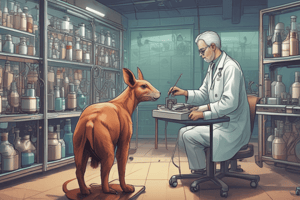Podcast
Questions and Answers
What is the main procedure described in the text for conducting the Draize test?
What is the main procedure described in the text for conducting the Draize test?
- Injecting the substance only in the upper eyelid
- Rinsing the eye immediately after injecting the substance
- Injecting the substance into one eye and using the other eye as control (correct)
- Injecting the substance into both eyes
How long should the material be left in the eye during the Draize test?
How long should the material be left in the eye during the Draize test?
- 12 hours
- 24 hours (correct)
- 48 hours
- 1 hour
What is discouraged when conducting the Draize test according to the text?
What is discouraged when conducting the Draize test according to the text?
- Skipping the grading and checking after 1, 2, and 3 days
- Using only one animal in the test
- Holding the lids together after injecting the substance
- Routinely using extra animals to measure irrigation impact (correct)
Which of the following is recommended for animal population in regulatory standards according to the text?
Which of the following is recommended for animal population in regulatory standards according to the text?
What is the significance of initial reaction to discomfort during instillation according to the text?
What is the significance of initial reaction to discomfort during instillation according to the text?
Why does the importance of determining reaction reversibility decrease with increasing initial irritating response severity according to the text?
Why does the importance of determining reaction reversibility decrease with increasing initial irritating response severity according to the text?
Which method provides information on health hazards likely to arise from exposure to test substances via intradermal injection and/or epidermal application?
Which method provides information on health hazards likely to arise from exposure to test substances via intradermal injection and/or epidermal application?
Which test uses animals and should only be conducted as a last resort for animal welfare reasons?
Which test uses animals and should only be conducted as a last resort for animal welfare reasons?
Which test has been shown to be less sensitive than the Guinea Pig Maximisation Test?
Which test has been shown to be less sensitive than the Guinea Pig Maximisation Test?
What do both the GPMT and Buehler Tests provide data on?
What do both the GPMT and Buehler Tests provide data on?
When should the Buehler and Guinea Pig maximization tests be conducted according to the text?
When should the Buehler and Guinea Pig maximization tests be conducted according to the text?
What is a key difference between the GPMT and Buehler Test mentioned in the text?
What is a key difference between the GPMT and Buehler Test mentioned in the text?
How many days does the GPMT testing take approximately?
How many days does the GPMT testing take approximately?
What should be the concentration of test chemicals for each induction exposure in GPMT?
What should be the concentration of test chemicals for each induction exposure in GPMT?
How many animals are required in the treatment group for BUEHLER testing?
How many animals are required in the treatment group for BUEHLER testing?
When should the induction period occur in the BUEHLER testing?
When should the induction period occur in the BUEHLER testing?
What is the significance of a 'closed patch' in BUEHLER testing?
What is the significance of a 'closed patch' in BUEHLER testing?
How long after removing the patch are observations made following challenge exposure in BUEHLER testing?
How long after removing the patch are observations made following challenge exposure in BUEHLER testing?
What statistical measure is typically used to express the variability of data from all individual repetitions?
What statistical measure is typically used to express the variability of data from all individual repetitions?
Which parameter is used as an average value in the context of the KeratinoSens™ test method?
Which parameter is used as an average value in the context of the KeratinoSens™ test method?
In which test method are fold luciferase induction activity and viability values typically tabulated?
In which test method are fold luciferase induction activity and viability values typically tabulated?
What measure is used to calculate the variability in luminescence readings for the solvent/vehicle/negative control in each experiment?
What measure is used to calculate the variability in luminescence readings for the solvent/vehicle/negative control in each experiment?
What does EC1.5 represent in the context of the text provided?
What does EC1.5 represent in the context of the text provided?
Which parameter is typically used to assess the prediction model rating of the test chemical?
Which parameter is typically used to assess the prediction model rating of the test chemical?
What is the recommended ratio for incubating cysteine and lysine peptide solutions with the test chemical?
What is the recommended ratio for incubating cysteine and lysine peptide solutions with the test chemical?
What is the incubation temperature specified for the reaction solution?
What is the incubation temperature specified for the reaction solution?
How many calibration solutions should be prepared to cover the range for both cysteine and lysine peptides?
How many calibration solutions should be prepared to cover the range for both cysteine and lysine peptides?
What is the minimum r2 value recommended for suitable calibration curves?
What is the minimum r2 value recommended for suitable calibration curves?
How is peptide depletion monitored in the test described?
How is peptide depletion monitored in the test described?
When should a single HPLC analysis be considered sufficient for a test chemical in the Direct Peptide Reactivity Assay (DPRA)?
When should a single HPLC analysis be considered sufficient for a test chemical in the Direct Peptide Reactivity Assay (DPRA)?
Flashcards are hidden until you start studying
Study Notes
Draize Test Overview
- Conduct the Draize test by instilling a test substance into the eye of a rabbit to assess irritation.
- The test material should remain in the eye for an appropriate duration to evaluate reactions effectively.
- It is discouraged to use anesthetics or restraint during the Draize test, as it can affect the outcome.
Regulatory Standards for Animal Testing
- Regulatory standards recommend using established animal populations to enhance reliability in testing procedures.
- Initial reactions to discomfort during instillation are significant for assessing the irritant potential of the substance.
Reaction Reversibility
- The importance of determining reaction reversibility decreases as the initial irritation severity increases, indicating a likely prolonged or permanent effect.
Alternative Testing Methods
- The Intradermal and Epidermal Test provides information on health hazards from test substances through their respective application methods.
- Animal testing, particularly the Draize test, should only be conducted as a last resort to prioritize animal welfare.
Sensitivity of Tests
- The Draize test is shown to be less sensitive compared to the Guinea Pig Maximisation Test (GPMT), which provides better insights into sensitization potential.
GPMT and Buehler Tests
- Both GPMT and Buehler Tests provide data on skin sensitization.
- Conduct Buehler and GPMT tests when assessing potential allergic reactions to substances, especially in high-risk categories.
Key Differences Between Tests
- A key difference between GPMT and Buehler is the length and methods of exposure to the test substance.
- GPMT testing takes approximately 10 to 14 days to complete.
- Concentration of test chemicals should be specified for each induction exposure in GPMT to ensure consistent results.
Testing Requirements
- The Buehler test requires a minimum of two animals in the treatment group for accurate data collection.
- Induction periods in Buehler testing must be scheduled properly to observe reactions.
- A 'closed patch' in Buehler testing is significant for controlled exposure without environmental interference.
Observations and Data Variability
- Observations after removing a challenge exposure patch are typically made 24 to 48 hours later.
- Variability of data from all repetitions is often expressed using standard deviation or standard error.
KeratinoSens™ Test Parameters
- Average values in the KeratinoSens™ test method are represented by fold luciferase induction activity.
- Variability in luminescence readings for controls is calculated to ensure data reliability.
- EC1.5 indicates the concentration at which 1.5-fold increase in luciferase induction occurs.
Assessing Prediction Model Ratings
- The prediction model rating of test chemicals typically uses the average induction values across experiments.
- Recommended incubation ratio for cysteine and lysine peptide solutions with test chemicals is commonly set during testing.
Incubation Conditions and Calibration
- Incubation temperature for the reaction solution is usually maintained between specified limits.
- A minimum of five calibration solutions is required to effectively cover the range for both cysteine and lysine peptides.
- Minimum r² value of 0.98 is recommended for suitable calibration curves to ensure accuracy.
Peptide Depletion Monitoring
- Peptide depletion in the Direct Peptide Reactivity Assay (DPRA) is monitored using analytical techniques, typically HPLC.
- A single HPLC analysis is sufficient for testing if the test chemical shows clear and consistent reactivity.
Studying That Suits You
Use AI to generate personalized quizzes and flashcards to suit your learning preferences.




